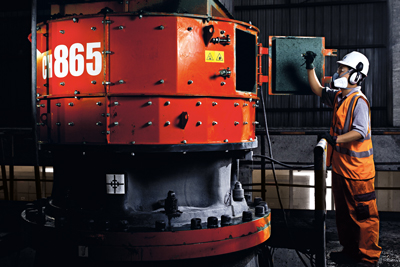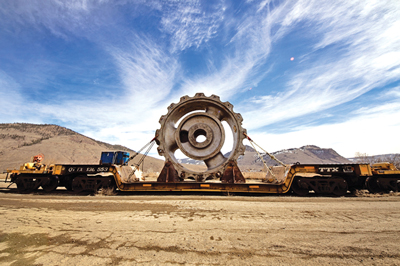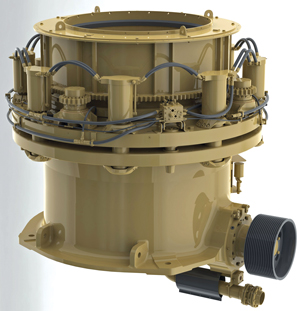The knowledge base associated with secondary/tertiary crushing of hard rock minerals has grown exponentially over the past century or so, starting with the realization—reported by an industry expert in the July 1916 issue of E&MJ—that “probably the most important development in ore crushing in recent years is the growth of the idea that no machine in existence is capable of crushing ore efficiently from large pieces to the fine meshes necessary in preparing most ores for treatment…
Modern metallurgists recognize the advantages of stage crushing and the mills designed at the present time are arranged to take advantage of it.”
Today, fine/pebble crushing is an integral part of most large hard rock mills, and crusher suppliers keep expanding the available options for outfitting secondary crusher plants to suit the needs of specific mine-site characteristics. The prevailing features of these new models emphasize improved capacity, control, energy consumption and ease of maintenance.
Both Metso and Sandvik have, in the past few months, introduced new models of cone or gyratory crushers that can accommodate customer demands for these capabilities. Other manufacturers, such as FLSmidth, Telsmith and ThyssenKrupp Fördertechnik also offer relatively new and highly capable cone crusher models as well with their Raptor, T Series and Kubria lines, respectively.
 |
| Sandvik recently introduced the CH865 cone crusher, intended for tertiary and pebble crushing, and the CH860 for high-capacity secondary crushing. |
SANDVIK EXPANDS ITS MID-RANGE
Sandvik Mining added to its CH800 series of mining cone crushers by launching two models in the mid-range segment. The new CH860 is designed for high-capacity secondary crushing, while the CH865 is intended for high-reduction tertiary and pebble applications; both feature higher crushing forces relative to mantle diameter and a 500-kW motor. According to the company, both new crushers combine a range of advanced automation features for a more secure and productive process.
“We scaled down our larger Sandvik CH890 and Sandvik CH895 mining cone crushers to create two mid-range models,” said Andreas Christoffersson, product line manager for cone crushers at Sandvik Mining. “Depending on the application, [the] CH860 and Sandvik CH865 outperform competing equipment in the mid-range segment by as much as 30% and deliver a twofold increase in performance range.”
Intelligent systems in the CH860 and CH865 are claimed to enable real-time performance optimization, while innovative design solutions reduce dynamic loads and minimize engineering and installation work. The crushers feature fewer moving parts than competing models, according to Christoffersson. Bolted, not welded, liners on the top and bottom shell enable safer, easier maintenance.
Both new crushers also feature the company’s ASRi (Automatic Setting Regulation control system) and Hydroset to ensure automatic operation at peak performance around the clock. ASRi constantly monitors pressure, power draw and mainshaft position and automatically adjusts the setting during full load.
The Hydroset main shaft support system provides protection from overloads by permitting tramp iron and other uncrushable items to pass through the crusher before automatically returning to the original setting. The system automatically compensates for crushing chamber wear to provide consistent product size.
“Hydroset enables us to incorporate our unique PLC-controlled electric dump valve for tramp iron protection, which significantly reduces pressure peaks and mechanical stress on the crusher, greatly improving reliability,” Christoffersson explained.
Nearly a year’s worth of rigorous testing in a Chinese iron ore mine has produced excellent results, according to the company.
“Mines are often looking for increased productivity without necessarily expanding their plant,” Christoffersson said. “[The] CH860 and Sandvik CH865 are easy to install as replacements to achieve this. In the test site, we replaced a similar sized crusher, on the same foundation, to greatly increase final product and significantly extend crushing chamber liner life. The electric dump valve repeatedly proved its tramp iron protection value, reducing costly unplanned breakdowns.”
 |
| Metso’s Nordberg GP7 gyratory crusher. |
METSO’S LARGEST NORDBERG GYRATORY
Metso expanded its range of high-capacity crushers with the introduction of the Nordberg GP7, its largest Nordberg GP secondary gyratory crusher to date. The 58-ton unit features a combination of feed opening, cavity design and capacity that, according to Metso, ensures high crushing performance with even the hardest feed and helps keep operational costs low. In addition, said Metso, the crusher is safe to operate and simple to maintain.
The Nordberg GP7 can be fed with a large primary crusher such as the Nordberg C200 jaw crusher or Nordberg Superior primary gyratory crusher, and followed by a Nordberg HP6 cone crusher for tertiary crushing. The GP7 has the same footprint as the Symons 7-ft and similar crushers, which makes replacement of an existing crusher easy to accomplish.
The crusher features a feed opening of 450 mm (18 in.), which remains constant throughout the lifetime of the liners—offering one of the most significant benefits of the new crusher. A constant feed opening ensures steady performance and stable end-product quality, which translate into predictable revenue and process throughput. Process control is based on advanced Metso IC automation that provides easy, safe and trouble-free operation.
The GP7 offers seven stroke options to ensure adaptability for any application. A steep cavity combined with an easily changeable stroke provides high performance at power ratings up to 550 kW. In fact, said Metso, the Nordberg GP7 has the highest power rating in its size class.
The machine has a minimal number of service points, all of which can be accessed safely and easily, according to the company, and is delivered with all tools required for safe maintenance work.
Meanwhile, two Metso MP2500s, billed as the world’s largest cone crusher, are currently being installed at First Quantum Minerals Ltd.’s Sentinel copper mine in Zambia. According to Metso, depending on the ore characteristics and SAG efficiency, the MP2500’s could provide a throughput range of 3,000–4,500 metric tons per hour (mt/h). (See E&MJ, December 2014, p. 102).
 |
| Metso’s Nordberg GP7 gyratory crusher. |
FLSMIDTH’S XL2000 WIDENS; FLOWSHEET OPTIONS
Recognizing the industry’s steady trend toward larger equipment size, capacity and tonnage, FLSmidth introduced its Raptor XL2000 cone crusher to meet these new challenges. Although it’s not new, having been introduced several years ago, the XL2000 remains the flagship model in the Raptor cone crusher line, topping the XL300, XL400, XL500, XL600, XL900, XL1100 and the newer XL1300.
The XL2000 cone crusher is intended for secondary or tertiary applications and does not replace the need for a primary gyratory or jaw crusher. However, the XL2000 can replace a SAG mill, according to the company, thereby reducing overall costs while still maintaining circuit capacity and producing a product crushed to specific requirements.
Due to the large size and weight of the main frame required for the XL2000, FLSmidth engineers involved in its design borrowed concepts from the company’s primary gyratory two-piece frame with its taper-interlock connection. This two-piece frame allows flexibility in sourcing, transport and ease of handling on site.
The 2,000-hp XL2000 has high crushing force (4,220,000 lb/1,914,000 kg) with advanced head-motion dynamics. To safely apply this force, FLSmidth engineers focused on ensuring the structural integrity of all major components. Component mass was critical, and the company said the machine’s design reflects what is expected of a robust 2,000-hp cone crusher that must reliably and durably handle the tough material characteristics and applications for which it was designed.
Notable features of the XL2000 cone crusher include:
• Double-acting tramp and clearing cylinders;
• A sleeved main shaft to allow for rapid disassembly and access to all bronze bearings/bushings for inspection and (if required) replacement; and
• Improved design of T/U seal location to eliminate failures caused by material ingress.
FLSmidth believes the XL2000 creates new opportunities for miners to link cone crushers directly to the primary crushing station. Instead of settling for a 180- to 200-mm product from a 6,000-t/h primary gyratory crusher, the XL2000 could supplement that primary gyratory to produce up to 10,000 t/h and a 125-mm product that is ready for more efficient crushing in the next stage, according to the company.
Copper Mountain Mining installed an XL2000 Raptor at its flagship mine in southern British Columbia last year, as part of a $40 million program to increase its secondary crushing capacity and improve mill efficiency. The new Copper Mountain machine is regarded as the largest cone crusher installed in western Canada and has the ability to crush 6-in. rock from the primary crusher down to minus 2 in., which will allow the mill to operate consistently at or above design capacity rates of 35,000 t/d.
 |
| Telsmith’s recently introduced T400 cone crusher has a 1,321-mm diameter head, 1,397-mm receiving hopper and 605-mm crusher sleeve. It’s the latest in the company’s line of T series cones, topped by the T900 model pictured here. |
TELSMITH’S MID-SIZED NEWCOMER
Telsmith rolled out its T400 cone crusher in 2014, filling another slot in the T Series line that includes the high-capacity, mine-duty T900 and the smaller T300. The T400 feature set includes a 1,321-mm diameter head, a 1,397-mm receiving hopper, replaceable mainframe liners, epoxy-secured manganese steel crushing members and more.
The T400 is equipped with Telsmith’s innovative “hybrid” bearings that have a washer and ramp design, which replaces the conventional use of a socket, socket liner and head ball—all of which typically involve time-consuming removal when servicing the machine. Telsmith noted that, unlike roller bearing machines, these large hybrid bearings have both static and dynamic lift, providing substantially better lift overall to efficiently handle the crushing forces.
The T Series line offers nominal output capacities ranging from 110 to 2,100 mt/h with power ratings from 220 kW (300 hp) in the smallest size to 660 kW (900 hp) at the high end of the line. Design features include large clearing circuits, a patent-pending, anti-spin feature that prevents head spin to help extend manganese service life. The use of a single bowl for all liners helps reduce downtime and inventory costs.









